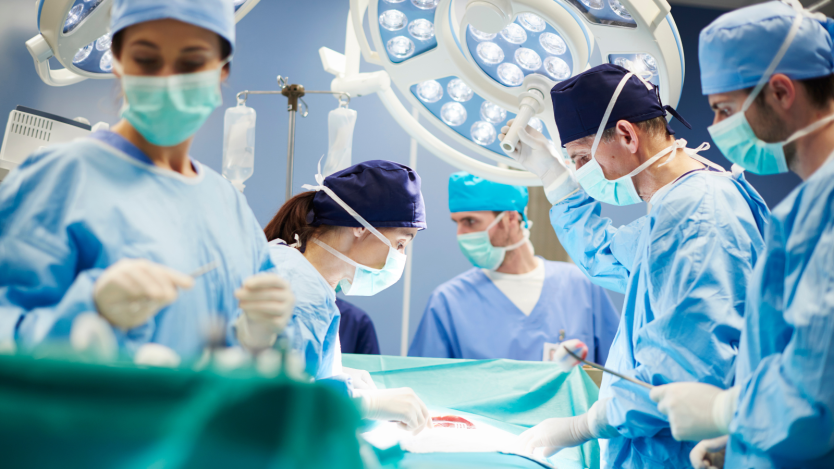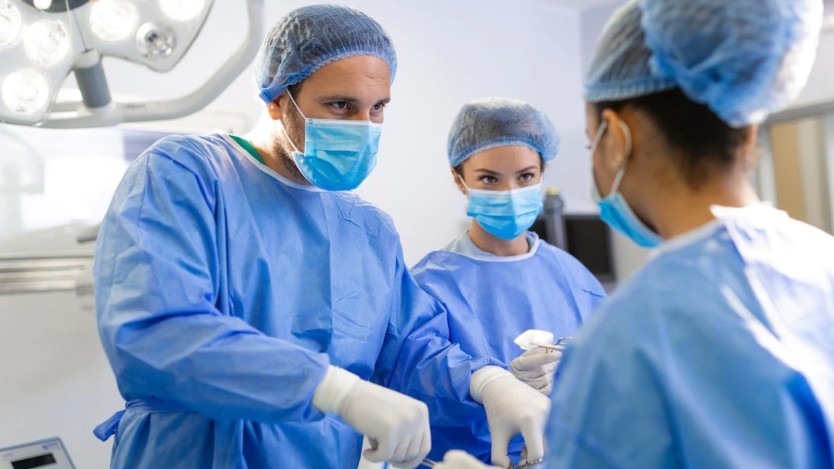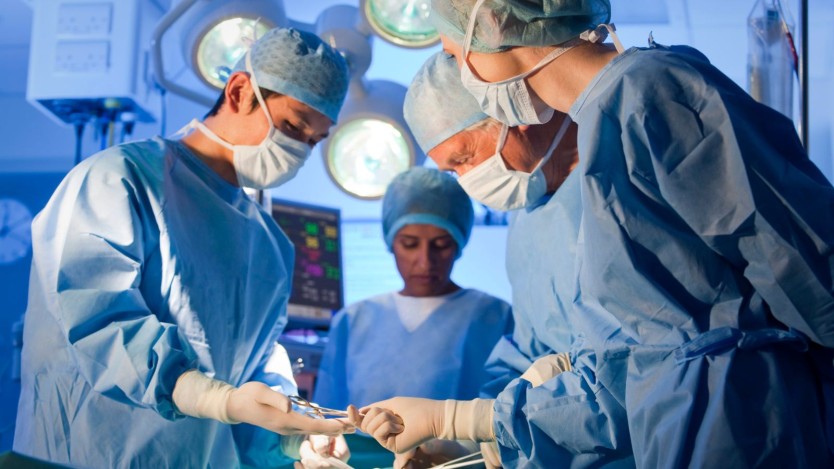Eventration: what it is, causes, symptoms and treatments

- What is eventration?
- Types of eventration
- What are the causes of eventration?
- What are the symptoms of eventration?
- Diagnosis of eventration or incisional hernia
- Treatments for eventration
- Request a surgical assessment consultation for eventration surgery
What is eventration?
- An eventration is a hernia that appears in the abdominal area as a result of incorrect healing of the incision made during surgery.
- Eventrations can be classified according to the abdominal area in which they are located, how they are formed and how they are externalised.
- Specialists recommend surgical treatment for complete removal of an eventration, either by open surgery or laparoscopic surgery.
An eventration or incisional hernia as a result of incorrect healing of the incision made during surgery. This is a wound that has closed poorly or has not healed properly, resulting in tissue damage.
This situation causes the affected tissues to separate and the viscera can move into the fatty tissue beneath the skin.

Free Assessment for Contracting Medical Services
Operarme’s Patient Service will contact you and solve all your questions on the medical service you need.
The formation of an eventration appears in the form of a lump in the abdominal area where the operation was previously performed. Although it does not usually cause pain, the patient may experience discomfort. If they are not treated in time, they can lead to strangulation, which is why it is advisable to see a specialist as soon as the problem is detected.
There are three important elements that make up the eventration: the ring, the sac and the contents.
Ring
The annulus or eventration orifice is formed by contracted muscular borders invaded by fibrous tissue. The edges of this ring or parietal defect are accurately determined by palpating the eventration while the patient is lying down. In this way the specialist can determine its thickness and consistency.
Sac
The eventration sac is formed when the aponeurotic muscle separation begins. The aponeurosis is a thin membrane that envelops the muscles whose function is to bind the musculature together. When the separation occurs, the sac is formed by fibrous connective tissue, which adheres to the scar.
Contents
The contents of the sac can vary, it can be the omentum, the small intestine, both at the same time, or the colon. This content may be reducible or irreducible, the reason for not being able to reduce it is when the content is stuck inside the sac. There is also the possibility that it may be strangulated, reaching the maximum level of severity.
Here are some more details about this problem, its types, symptoms and treatments.
Types of eventration
Depending on the process of eventration formation, there are the following classifications:
Chronic eventration
This is a painful lump or mass whose shape, size and intensity vary from case to case. Small eventrations are usually detected by the physician in a routine clinical examination.
The increase in size occurs slowly, but they may grow to large dimensions, resulting in a change of location of the intestines, moving them out of the abdomen into the eventration pouch.
During the diagnostic phase, the specialist usually observes a bulge in the abdominal area that protrudes, especially on exertion.

Do you need a diagnosis from a general surgeon?
Purchase your private consultation easily under Operarme's guarantees and select your nearest clinic/hospital.
They usually have a smooth surface, although they may be irregular in shape, falling by their own weight on the abdomen in the form of a pouch. The overlying skin is thin, pigmented and the scar mark is visible.
Acute eventration
Acute eventration or laparotomic dehiscence is the division and separation of the edges of a sutured surgical wound, with or without exteriorisation of the contents of the abdominal cavity. They may be:
- Partial dehiscence: Also called acute covered eventration. This occurs when the deep parietal planes (peritoneum, muscles and aponeurosis) that make up the inside of the abdomen give way, but the skin remains unharmed because it is a more resistant and flexible layer.
- Complete dehiscence: This is when all the planes or layers of the abdominal wall have separated, including the skin. Sometimes the intestine, protected by a layer of fibrin, does not show through the wound. Other times it can be clearly visible, requiring emergency surgery.
An eventration can occur in different places in the abdomen. It is referred to as follows:
- Medial eventration: These are the most frequent and appear in the midline of the abdomen, i.e. the central area of the belly. To be more specific, this type can be differentiated into several subtypes:
- Epigastric and periumbilical, when the problem is in the epigastric midline and in the vicinity of the umbilical region. This is the central area from the umbilicus to the upper abdomen.
- Subumbilical, located in the infraumbilical midline, i.e. below the umbilicus.
- Lateral eventration: These are less frequent than medial eventrations, occurring in approximately 20% of cases. These are also differentiated into two subtypes:
- Iliac, they occur when the lower edge of the hernia ring is formed by the psoas muscle and the horizontal branch of the pubis, these areas are located on the sides of the abdomen.
- Lumbar, secondary to lumbo laparotomy. The eventration appears in the lumbar region and is externalised in the abdomen.

What are the causes of eventration?
Eventrations, also called incisional or ventral hernias, are complications caused, as mentioned above, by poor healing after abdominal surgery.
This condition may occur in some cases that have undergone an intervention in the abdominal area, regardless of whether it was a hernia or not.

As well as being caused mainly by poor healing, it can also be caused by other factors such as:
- Obesity, high weight causes excessive pressure on the abdomen. This facilitates the appearance of bulges that can lead to the formation of ventral hernias.
- Advanced age. With age, wounds are more likely to take longer to heal, which, together with other risk factors such as exertion before recovery is complete, can lead to malformation in the healed area.
- Malnutrition causes dysfunctions such as muscle weakness, altered vital response capacity and altered body fluid flow.
- Ascites or liver and kidney problems (uremia), which is the accumulation of fluids inside the abdomen due to liver or kidney malfunction.
- Post-surgical haematoma. This can occur due to haemostasis during the operation, causing the appearance of haematomas. These can become infected and cause the removal of the stitches, resulting in a defenceless area with the possibility of forming hernias.
- Smoking or chronic coughing, resulting in overexertion of the abdominal area.
- Multiple pregnancies, the weight and space occupied by the foetus during pregnancy causes excessive pressure to be generated on the abdominal walls, weakening them and exposing the abdomen to the possible formation of ventral hernias.
- Lifting heavy objects or intense physical exercise. These types of activities make it possible for hernias to form due to overstraining of the area and increased pressure during exercise.
To detect that the patient is suffering from eventration, he or she may notice different symptoms, the most common being the appearance of a lump in the area of the incision. Below, we discuss the other signs of eventration.
What are the symptoms of eventration?
The symptoms of eventration may vary from case to case, but the most common symptom is the appearance of a deformity in the abdominal wall in the area of the scar or close to it.
This usually occurs near the umbilicus and also in the centre or midline of the abdomen. The presence of this formation is usually accompanied by discomfort and pain, the degree of which can vary.
It is also possible that the intestine inside the hernial sac with adhesions to it may cause alterations in the functioning of intestinal transit, leading to episodes of obstruction.

Do you need a diagnosis from a general surgeon?
Purchase your private consultation easily under Operarme's guarantees and select your nearest clinic/hospital.
Another serious symptom of eventration is episodes of incarceration, i.e. the viscera are trapped inside a narrow hole, the hernia. If not detected in time, this can lead to strangulation of the organ. In these cases the pain is very intense, the area of inflammation of the eventration increases and the patient may develop a fever.
If strangulation occurs, there will be a marked decrease in the circulation of the contents of the intestine or colon, and if time is allowed to elapse, perforation of the intestine may result.
Diagnosis of eventration or incisional hernia
To make the diagnosis, the specialist will first look for and examine the lump in the abdomen by palpation. To make the examination easier, the doctor may ask the patient to make abdominal efforts, such as coughing or contracting the abdominal muscles.
Other secondary tests that allow a closer look at the formation of the eventration include:
- Ultrasound, a test that shows the inside of the abdomen, allowing the state of the organs and tissues to be observed.
- CT (Computerised Axial Tomography). This test makes it possible to observe the state of the hernia, its size and provides information on what is causing it. It is performed by means of X-rays, which show images of the inside of the patient's abdomen.

Treatments for eventration
After diagnosis, surgery is usually recommended to remedy the discomfort, pain or possible complications caused by the eventration. Two types of treatment are normally performed. On the one hand, open surgery or hernioplasty, and on the other hand, laparoscopic surgery or hernioplasty. These interventions consist of correcting the defect and proceeding to place a mesh.
The type of mesh or wall prosthesis that is inserted to correct the deformity will depend on the type of eventration, conditions that affect the patient's recovery, such as infections, and the position of the mesh, taking into account the affected area.
Surgery or open hernioplasty
This technique consists of opening the patient through the abdominal area and examining and intervening on the inside. The steps involved in open hernioplasty for eventration are as follows:
- First, the patient is anaesthetised, preventing any discomfort or pain during the surgery.
- After anaesthesia, the surgeon makes an incision of about 5-10 cm to reach the bulge.
- Once the surgeon has reached the eventration, he or she repositioned the part of the contents that was outside.
- Once the contents have been repositioned, the specialist will place a surgical mesh where the defect is located, so that it performs the function of the abdominal wall and prevents the protrusion from occurring again.
- To finish the intervention, the specialist will close the wound with stitches.
This procedure usually lasts between 30 and 40 minutes.
Laparoscopic surgery or hernioplasty
Unlike open surgery, in this type of surgery only a few small incisions are made to solve the eventration. This intervention consists of:
- The first step in the operation is to give the patient anaesthesia.
- As soon as the anaesthesia takes effect, the surgeon makes 3 or 4 small incisions in the area where the eventration is located.
- Through one of the incisions, the surgeon inserts a laparoscope, which is a surgical instrument with a tiny camera and a light source at one end that allows the doctor to see inside the patient's abdominal cavity.
- Through the other incisions made, other surgical instruments are inserted to allow the patient to be operated on correctly.
- Once the ventral hernia has been repaired, the surgeon places a surgical mesh made of synthetic material in the damaged area of the abdomen to strengthen the area and prevent the hernia from recurring.
- Finally, the surgeon sutures the incisions.
In contrast to open surgery, laparoscopic surgery lasts between 90 and 120 minutes.
Although this procedure takes longer, it has important advantages, which are:
- Shorter recovery time for the patient
- Smaller scars, they are almost imperceptible due to the tiny size of the incisions made.
- Less postoperative pain.
Request a surgical assessment consultation for eventration surgery
If you need more information about the eventration surgery or you would like to have an assessment consultation, please contact our patient service department directly.

Do you need a diagnosis from a general surgeon?
Purchase your private consultation easily under Operarme's guarantees and select your nearest clinic/hospital.
Medical disclaimer: All the published content in Operarme is intended to disseminate reliable medical information to the general public, and is reviewed by healthcare professionals. In any case should this information be used to perform a diagnosis, indicate a treatment, or replace the medical assessment of a professional in a face to face consultation. Find more information in the links below:
